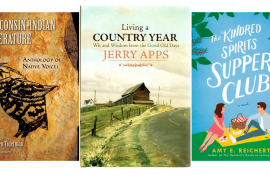By Shelby Deering | Photo courtesy of Carol Zimmerman
Thanks to the hospitable lake environment, sprawling prairies and towering, old-growth trees, birds of all kinds flock to the Lake Geneva region. Downy woodpeckers, sandhill cranes, goldfinches, cardinals and Great Blue herons are just some of the beautiful birds that call this area home. But not everyone realizes that all of the area’s birds — both resident and migratory — have a local, municipal committee on their side, encouraging sound environmental preservation of bird habitats and promoting bird appreciation in the community.
Formed in 2011 with six citizen appointees and one alderperson, the Lake Geneva Avian Committee promotes the protection of area birds and sponsors a variety of activities for the public, offering community fun and education related to birding. Since its formation more than a decade ago, the committee has successfully achieved its goal to have Lake Geneva named an official “Bird City Wisconsin.”
Amid the 96 recognized Bird Cities in the state, Lake Geneva is one of 32 that have achieved “High Flyer” status, meaning that the city has gone above and beyond when it comes to bird habitat conservation and public education. The city of Lake Geneva is in good company with fellow “High Flyer” Bird City Williams Bay.
To be named a Bird City, the Wisconsin town has to meet six requirements, including habitat protection and monitoring, removal of threats to birds and outreach with the public. These are things that the Lake Geneva Avian Committee does in spades. As Lake Geneva Avian Committee member Carol Zimmermann explains, the committee sponsors several annual projects and events to promote local birding.
One such project is a partnership with Alliant Energy. Using a grant from that company, the committee has been able to purchase and loan out bird-watching kits from the Lake Geneva Public Library. “The vivid green shoulder-strap bags have a pair of binoculars, bird identification resources and information on birding hot spots around Lake Geneva,” Zimmermann shares, adding that with the popularity of the program, the committee hopes to inspire new birdwatchers and to make this “gentle sport” accessible to everyone, regardless of their income.
Another project sponsored by the Avian Committee is a multi- disciplinary curriculum through the Lake Geneva Schools. Called “Learning to Soar,” the semester- long program introduces fifth-grade students to basic facts about birds and migration, culminating in a research- based experience that students share with the public during an event intended to inspire local residents to understand and enjoy birds.
For the past three years, this research-based experience has taken the form of a student-created “Storybook Trail” at the Four Seasons Nature Preserve on Highway H in Lake Geneva. Zimmermann says that this project is designed to promote bird watching for children and families and has served as the capstone for the curriculum. “The students are asked to complete the trail using a process called project- based learning,” Zimmermann says. “Students meet with ‘clients’ to understand the project requirements. In our case, the clients are the members of the Avian Committee. The mission that we give the students is that they create a trail experience that inspires younger, first-grade level readers to learn about migratory birds.”
The project also involves the fifth- grade students writing and illustrating an original story about a bird who migrates to the preserve. Zimmermann explains that the pages of the book the students create correspond to nine specific locations along the trails in the nature preserve. The pages are then posted at each location on the trail, along with an “amazing bird fact” and an activity that a child can complete on site, creating the interactive “Storybook Trail.”
In the past three years, the original stories have focused on a family of tree swallows and the migration journeys of bluebirds and purple martins, which are plentiful in the Lake Geneva area. In fact, there are dozens of purple martin houses that can be spotted along the Geneva Lake Shore Path, carefully tended by Lake Geneva Avian Committee members.
Zimmermann says that each of the purple martin “condos” has multiple nest boxes for these cavity-dwelling birds to occupy when they migrate to Lake Geneva from South America in the spring. Volunteers check on the birds multiple times per week to inspect nest boxes for eggs and, later, check on the welfare of the nestlings. As a result of these efforts, the local migratory colony continues to thrive.
Another busy spot for feathered friends? The Geneva Lake Museum’s decommissioned chimney, which has become a communal roost for visiting chimney swifts.
As the hollow trees preferred by these swifts are increasingly cut down, the birds have adapted to chimneys as a suitable habitat to build their nests. In early autumn, thousands of swifts roost in the museum’s chimney,
coming out at dusk to eat as many insects as they can.
As they emerge from their chimney nest, these flocks of birds form a better living bird-watching vortex that Zimmermann says is truly hypnotic to observe. The natural show has become an annual tradition at the museum: “Swift Night Out.” The free program sponsored by the Avian Committee has become a big draw in recent years — over 250 people have attended past events.
Zimmermann says that there are plenty of reasons to care about the birds of Lake Geneva: the sheer joy of hearing their songs and calls; spotting their vivid colors and patterns; their role in the ecosystem as natural bug control; and the fact that the act of bird- watching can provide us with an opportunity to get outdoors and enjoy our natural world.
This year’s Swift Night Out will take place on Thursday, Sept. 7. For more information, visit the Geneva Lake Museum website.





